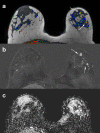Diffusion-weighted imaging of the breast: current status as an imaging biomarker and future role
- PMID: 33178933
- PMCID: PMC7592470
- DOI: 10.1259/bjro.20180049
Diffusion-weighted imaging of the breast: current status as an imaging biomarker and future role
Abstract
Diffusion-weighted imaging (DWI) of the breast is a MRI sequence that shows several advantages when compared to the dynamic contrast-enhanced sequence: it does not need intravenous contrast, it is relatively quick and easy to implement (artifacts notwithstanding). In this review, the current applications of DWI for lesion characterization and prognosis as well as for response evaluation are analyzed from the point of view of the necessary steps to become a useful surrogate of underlying biological processes (tissue architecture and cellularity): from the proof of concept, to the proof of mechanism, the proof of principle and finally the proof of effectiveness. Future applications of DWI in screening, DWI modeling and radiomics are also discussed.
© 2019 The Authors. Published by the British Institute of Radiology.
Figures






References
-
- Martí-Bonmatí L. Introduction to the stepwise development of imaging biomarkers : Imaging Biomarkers. 30: The British Institute of Radiology.; 2016. 9–27.
Publication types
LinkOut - more resources
Full Text Sources

